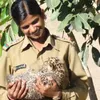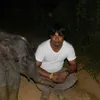With PM Modi all set to feature on Man vs Wild, here are the top 5 wildlife conservation initiatives from the government
While we eagerly await this special episode of PM Modi appearing on Man vs Wild, here is a list of the top projects and initiatives that the government of India has undertaken to protect the country’s wildlife and forest ecosystems.
On August 12, 2019, the world will watch Prime Minister Narendra Modi venturing into the wild forests of Uttarakhand along with television show host Bear Grylls on the popular show Man vs Wild on Discovery Channel.
Seen as an attempt to create awareness about animal protection and environmental conservation, the 45-second promo that was shared on Twitter recently, shows Modi interacting with Grylls, riding a dinghy and putting together a spear.
While we eagerly await this special episode, here is a list of the top wildlife projects and initiatives that the government of India has undertaken in recent years to protect the country’s wildlife and forest ecosystem.
Project Tiger
Project Tiger, introduced by the Indian government in 1973, aims to protect different species of tigers and also prevent their extinction by ensuring their natural habitats are free from threat.
Due to concentrated efforts in this regard, India has the highest number of Bengal tigers in the world, amounting to 2,226 according to an assessment conducted in 2014. The National Tiger Conservation Authority of India has also shown a 30 percent increase in the number of tigers. (from 1,706 in 2010, to 2,226 in 2014).
1565003702593.png?fm=png&auto=format)
An Indian Bengal tiger.
Image credit: Shutterstock
Project Tiger monitors tigers on a regular basis, helps in restoring natural habitats, organises anti-poaching operations, and provides a conducive environment for them to live and produce cubs, and also addresses human-wildlife conflicts.
In order to achieve these goals, the government works closely with the CBI, Wildlife Crime Control Bureau and the Police Department. The significance of this drive was such that it was included within the ambit of the Wildlife Protection Act, 1972.
Project Elephant
Project Elephant was launched by the Ministry of Environment and Forests, Government of India, in 1992. The objective of the drive is to safeguard the Asiatic elephants in the country by providing financial and technical support to states in which they are most prevalent.
1565003878454.png?fm=png&auto=format)
A wild Asian elephant with its baby.
Image Credit: Shutterstock
The project focusses on their natural environment as well as the mitigating corridors. Besides, the project lays emphasis on conducting ecological research and providing veterinary care for captive elephants.
Crocodile Conservation Project
The Crocodile Project was first floated in 1975, with the purpose of saving the three species of crocodiles known to Indian waters - the Gharial, Mugger, and saltwater crocodiles.
There was a rapid decline in the number of crocodiles in India during the late 70s, so much so that, they were on the brink of extinction. The main reason for this was irrational poaching and human settlements on the bank of rivers.
Crocodiles in Odisha were found to be the most affected due to irregular breeding cycles and low survival rates of hatchlings. As a result, the Government first launched the project in this state then extended it to other places.
1565004093580.png?fm=png&auto=format)
A saltwater crocodile, one of the biggest and largest of its kind.
Image credit: Shutterstock
The government roped in local people to create awareness about saving crocodiles. Wetland sanctuaries were built with crocodiles as the flagship species. Eggs of the reptile were collected and protected until birth, using the ‘rear’ and ‘release’ technique.
This was carried out by incubating the eggs at an appropriate temperature and humidity levels to induce hatching. The newly born crocodiles were then reared to be released into protected habitats. Several fishermen and villagers were employed to execute this project across the country.
UNDP Sea Turtle Project
According to the IUCN Red List, loggerhead and green sea turtles fall into the endangered category, Olive Ridley and Leatherback Sea Turtles into the vulnerable category and hawksbill sea turtles into the critically endangered category.
The sea turtle project was started to specifically preserve the Olive Ridley species of turtles from potential extinction. Known to be the smallest and most abundant of all sea turtles in the world, they are most likely to be found in the warm waters of the Pacific, Atlantic, and Indian oceans.
However, since their numbers were seen to be declining over the last few years, the species was identified as extremely ‘vulnerable’ by the World Wildlife Fund (WWF).
1565004222547.png?fm=png&auto=format)
An olive ridley sea turtle.
Image credit: Shutterstock
With a view to protect the Olive Ridley species, the Orissa Government made it mandatory for trawl boats to use Turtle Excluder Devices (TEDs). These devices consist of a net designed with an exit cover that allows turtles to escape while retaining the catch of fish.
However, several fishermen opposed this practice since they were of the belief that TEDs would get in the way of them catching fish.
WWF India, along with its partners, conducted a study to measure the loss of catch through TEDs, and found it to be very small in comparison to the total catch. As a result, many awareness sessions were held with the fishing community with a view to educate them about the importance of conserving turtles through TEDs.
Vulture Recovery Plan
Vultures once dominated skies across the world, with the highest populations found in India, Pakistan, and Nepal. But, their numbers have been declining in the last decade.
Known to feed on the carcasses of dead animals, these birds have always had an ecological, social, as well as cultural significance in India. They have not only helped keep the environment clean but also prevented the spreading of harmful diseases. Sacred to the Zoroastrian (Parsi) community, vultures are believed to liberate the souls of the dead.
The Government of India started a vulture research facility in Pinjore, Haryana in 2005 which turned out to be Asia’s first Vulture Conservation Breeding Centre.
1565004331986.png?fm=png&auto=format)
A long-billed vulture.
Image Credit: Shutterstock
After a considerable amount of scrutiny, it was found that a non-steroidal anti-inflammatory drug (NSAID) drug, Diclofenac used to treat vultures, had toxic properties. The drug was causing kidney failure and visceral gout in vultures, causing its population to dip.
In order to save the species from its harmful effect, the government initiated The Vulture Recovery Plan in 2006. Eventually, the sale of Diclofenac for veterinary purposes was banned and people were encouraged to use an alternative painkiller.
The very same year, the Bombay Natural History Society (BNHS) was established to lead the vulture conservation movement in India. The society managed to monitor the birds and their activities, release captive vultures into safe zones, and sensitise individuals about the need for protecting vultures.
As of today, India has three other vulture breeding facilities located at Guwahati in Assam, Buxa in West Bengal and Bhopal in Madhya Pradesh.
(Edited by Rekha Balakrishnan)











